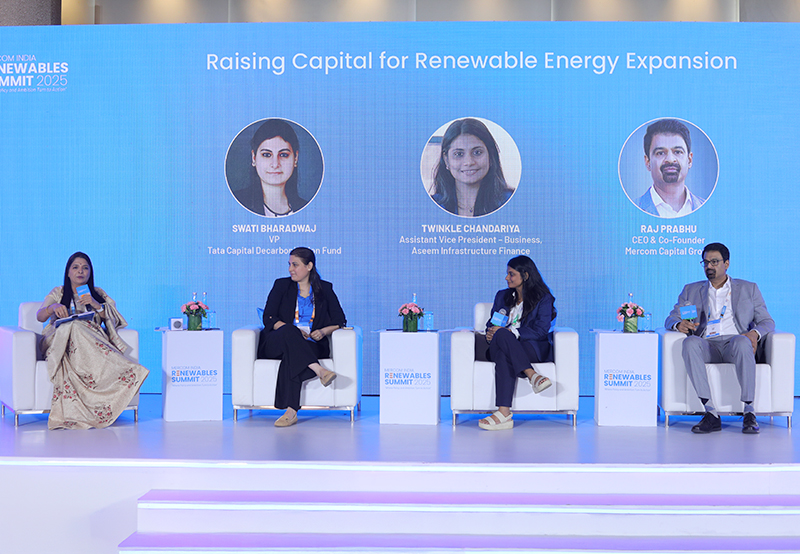India’s Renewable Energy Space is Mainstream Now for Lenders
Panelists at the Mercom Renewables Summit spoke about capital for renewables
August 1, 2025
Follow Mercom India on WhatsApp for exclusive updates on clean energy news and insights
Renewable energy in India is increasingly being viewed as a mainstream segment by lenders who are eager to finance different kinds of clean energy projects. Capital is no longer a constraint for well-governed companies with a good track record.
More and more players are coming into clean energy financing, both on the debt side and equity side. Several renewable energy companies have in recent months opted to raise money from the capital markets via initial public offerings (IPO), which can be a double-edged sword in terms of opportunities and risks.
Panelists at a discussion titled “Raising Capital for Renewable Energy Expansion,” held on July 25, 2025, at the Mercom India Renewables Summit in New Delhi, shared interesting perspectives on the approach of lending institutions towards clean energy financing in India at a time when global financing activity has been tepid.
Swati Bharadwaj, Vice-President at Tata Capital Decarbonisation Fund; Twinkle Chandariya, Assistant Vice-President at Aseem Infrastructure Finance; and Raj Prabhu, CEO and Co-Founder at Mercom Capital, shared valuable insights into the subject. Priya Sanjay, Managing Director at Mercom India, moderated the conversation.
In her remarks, Chandariya said Aseem Infrastructure had financed over 5 GW of projects from small-scale to large developers. The company’s disbursements were over ₹350 billion (~$4 billion) until now. India, she added, was a huge market that was attracting several global investors. “The size India offers is probably unmatched by any other market.”
She said renewable energy adoption in the commercial and industrial segment had gained the most traction from every stakeholder’s perspective. “It gives you a higher internal rate of return, gives you a lower cost of electricity.”
Chandariya commended the role played by the government in stabilizing the industry. “There is so much clarity on every aspect, like wheeling, banking, transmission, open access approvals, and connectivity policies. This gives comfort to all the parties in the agreement, which makes financing easier,” she said.
Sharing his insights, Prabhu spoke of how clean energy companies were aggressively accessing the capital markets. India has seen some 16 IPOs over the last 12 months, reflecting strong demand. He, however, cautioned that the IPO route can be risky too. He referred to policy changes in the U.S., which is a prime destination for Indian solar exports. “I can’t say whether it’s good or bad. Right now, it looks okay, but let’s see what it looks like when we meet here after the next 12 months.”
The panel sent out a clear message that financing was closely following renewable energy demand in India, with an increasing number of industries switching to green power because it makes commercial sense.
Prabhu said that while the Indian market is flush with IPO activity, funding for early-stage startups is lacking. “The investment community must look at this. When it comes to startups or technologies coming out of India, we have basically been licensing the technology of other countries. This has to change; if we are going to close down the whole ecosystem, and everything has to be made in India. If we are freezing foreign technologies from coming in, we have to invent some here; otherwise, we are going to be left behind.”
The panelists were unanimous that the next big funding opportunity lies in battery energy storage and round-the-clock power, given the shift of several industries to clean energy. They said they were, however, cautious about financing green hydrogen and manufacturing.
While the panelists were happy with policy stability in the renewable energy space, they also identified a few challenges from an investor’s standpoint, including limited exit options for equity players, delays in signing power purchase agreements, and land and evacuation approvals.
Prabhu felt data centers would be an interesting segment to invest in. “We are forecasting exponential growth in electricity consumption. The thought process in the U.S. is to have ample power to fuel AI data centres; we don’t want to slow down our economy. For India, also, I think it is an interesting market to invest in. The policy environment in India is stabilized now.”
